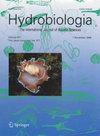瓦哈卡州拉恩特雷加礁带的碳酸盐收支平衡。南墨西哥太平洋
IF 0.3
4区 生物学
Q4 MARINE & FRESHWATER BIOLOGY
引用次数: 0
摘要
背景。珊瑚礁为沿海人类社区的可持续性提供了若干重要的地质生态功能。然而,在过去50年中,由于自然和人为干扰,珊瑚礁生态系统正在经历迅速退化。上述结果之一是碳酸盐产量的降低和这些体系结构的复杂性。特别是,在建造珊瑚礁的过程中,主要珊瑚物种的丧失损害了生态系统的功能。目标。在这项研究中,我们使用了ReefBudget方法的适应性来测量墨西哥瓦哈卡州拉恩特雷加(La Entrega)珊瑚礁中的碳酸钙预算。方法。在6个样带中估计了侵蚀鱼类(25 x 4 m)、海胆(25 x 2 m)的丰度和底栖动物的组成。结果。在进行相应的计算时发现,在La Entrega产生13.72 kg m-2 year-1(通常称为“G”)时,计算出的内生物侵蚀(包括海绵侵蚀)为5.65 G,海胆侵蚀为0.12 G,鱼类侵蚀为0.73 G;所得净碳酸盐收支为7.21 g, La Entrega礁的垂直生长速率为7.07 mm / 1。我们认为有必要提及的是,与加勒比或印度-太平洋地区的地层相比,拉恩特雷加的礁块相对较小(约324 x 233米)。结论。La Entrega的净产量高于大多数加勒比珊瑚礁(2-4 G)的估计,但低于印度-太平洋(5-14 G)。区域之间平衡的差异主要与每个区域构建物种丰度的差异有关。根据本研究的模拟,在RCP 4.5和2.6情景下(分别为4和7毫米),La Entrega珊瑚礁斑块呈现出足够的增长速度来应对可能的海平面上升。本文章由计算机程序翻译,如有差异,请以英文原文为准。
Carbonate Budget in the reef-patch of La Entrega, Oaxaca. Southern Mexican Pacific
Background. Coral reefs provide several important geo-ecological functions essential for the sustainability of coastal human communities. However, during the last 50 years, reef ecosystems are experiencing rapid degradation caused by natural and anthropogenic disturbances. One consequence of the above has been the reduction in the carbonate production rate and the structural complexity of these systems. Particularly, the loss of key coral species in the construction of reefs has compromised the functionality of the ecosystem. Objective. In this study we used an adaptation of the ReefBudget methodology to measure the calcium carbonate budget in the reef of La Entrega, Oaxaca, Mexico. Methods. Six transects were carried out to estimate the abundance of eroding fish (25 x 4 m), sea urchins (25 x 2 m) and the composition of the benthos. Results. When carrying out the corresponding calculations, it was found that in La Entrega 13.72 kg m-2 year-1 (commonly referred as “G”) are produced, the endobioerosion (including erosion by sponges) calculated was 5.65 G. The sea urchin erosion is 0.12 G and that of fish is 0.73 G; the resulting net carbonate budget was 7.21 G. The accretion rate (vertical reef growth) at La Entrega reef was 7.07 mm yr-1. We consider it important to mention that the reef patch at La Entrega is relatively small (approximately 324 x 233 m) compared to formations in the Caribbean or Indo-Pacific regions. Conclusions. Net production at La Entrega is higher than estimated for most Caribbean reefs (2-4 G) but lower than that of the Indo-Pacific (5-14 G). Differences in the balance between regions are mainly associated with differences in the abundances of builder species in each region. According to what was modeled in this work, the La Entrega reef patch presents a sufficient accretion rate to deal with a possible rise in sea level under the RCP 4.5 and 2.6 scenarios (4 and 7 mm, respectively).
求助全文
通过发布文献求助,成功后即可免费获取论文全文。
去求助
来源期刊

Hidrobiologica
生物-海洋与淡水生物学
CiteScore
0.40
自引率
0.00%
发文量
8
审稿时长
>12 weeks
期刊介绍:
HIDROBIOLÓGICA es una publicación cuatrimestral que difunde trabajos originales e inéditos de investigación o revisión, sobre temas relacionados con los organismos y la hidrología de los ambientes acuáticos, dulces y marinos y va dirigida a investigadores de todo el mundo, interesados en las diversas disciplinas que incluye la Hidrobiología , así como a alumnos de posgrados y licenciaturas relacionados con la biología, ecología, taxonomía, filogenia y evolución de organismos acuáticos, e hidrología y oceanografía de ambientes s dulceacuícolas y marinos.
 求助内容:
求助内容: 应助结果提醒方式:
应助结果提醒方式:


